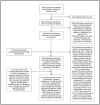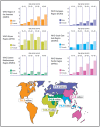Global estimates of prevalent and incident herpes simplex virus type 2 infections in 2012
- PMID: 25608026
- PMCID: PMC4301914
- DOI: 10.1371/journal.pone.0114989
Global estimates of prevalent and incident herpes simplex virus type 2 infections in 2012
Erratum in
-
Correction: Global estimates of prevalent and incident herpes simplex virus type 2 infections in 2012.PLoS One. 2015 May 20;10(5):e0128615. doi: 10.1371/journal.pone.0128615. eCollection 2015. PLoS One. 2015. PMID: 25992922 Free PMC article. No abstract available.
Abstract
Background: Herpes simplex virus type 2 (HSV-2) infection causes significant disease globally. Adolescent and adult infection may present as painful genital ulcers. Neonatal infection has high morbidity and mortality. Additionally, HSV-2 likely contributes substantially to the spread of HIV infection. The global burden of HSV-2 infection was last estimated for 2003. Here we present new global estimates for 2012 of the burden of prevalent (existing) and incident (new) HSV-2 infection among females and males aged 15-49 years, using updated methodology to adjust for test performance and estimate by World Health Organization (WHO) region.
Methods and findings: We conducted a literature review of HSV-2 prevalence studies world-wide since 2000. We then fitted a model with constant HSV-2 incidence by age to pooled HSV-2 prevalence values by age and sex. Prevalence values were adjusted for test sensitivity and specificity. The model estimated prevalence and incidence by sex for each WHO region to obtain global burden estimates. Uncertainty bounds were computed by refitting the model to reflect the variation in the underlying prevalence data. In 2012, we estimate that there were 417 million people aged 15-49 years (range: 274-678 million) living with HSV-2 infection world-wide (11.3% global prevalence), of whom 267 million were women. We also estimate that in 2012, 19.2 million (range: 13.0-28.6 million) individuals aged 15-49 years were newly-infected (0.5% of all individuals globally). The highest burden was in Africa. However, despite lower prevalence, South-East Asia and Western Pacific regions also contributed large numbers to the global totals because of large population sizes.
Conclusions: The global burden of HSV-2 infection is large, leaving over 400 million people at increased risk of genital ulcer disease, HIV acquisition, and transmission of HSV-2 to partners or neonates. These estimates highlight the critical need for development of vaccines, microbicides, and other new HSV prevention strategies.
Conflict of interest statement
Figures




Similar articles
-
First estimates of the global and regional incidence of neonatal herpes infection.Lancet Glob Health. 2017 Mar;5(3):e300-e309. doi: 10.1016/S2214-109X(16)30362-X. Epub 2017 Jan 31. Lancet Glob Health. 2017. PMID: 28153513 Free PMC article.
-
Estimated economic burden of genital herpes and HIV attributable to herpes simplex virus type 2 infections in 90 low- and middle-income countries: A modeling study.PLoS Med. 2022 Dec 15;19(12):e1003938. doi: 10.1371/journal.pmed.1003938. eCollection 2022 Dec. PLoS Med. 2022. PMID: 36520853 Free PMC article.
-
Estimated global and regional incidence and prevalence of herpes simplex virus infections and genital ulcer disease in 2020: mathematical modelling analyses.Sex Transm Infect. 2025 May 19;101(4):214-223. doi: 10.1136/sextrans-2024-056307. Sex Transm Infect. 2025. PMID: 39658199 Free PMC article.
-
Global and Regional Estimates of Prevalent and Incident Herpes Simplex Virus Type 1 Infections in 2012.PLoS One. 2015 Oct 28;10(10):e0140765. doi: 10.1371/journal.pone.0140765. eCollection 2015. PLoS One. 2015. PMID: 26510007 Free PMC article.
-
Global and regional estimates of the contribution of herpes simplex virus type 2 infection to HIV incidence: a population attributable fraction analysis using published epidemiological data.Lancet Infect Dis. 2020 Feb;20(2):240-249. doi: 10.1016/S1473-3099(19)30470-0. Epub 2019 Nov 18. Lancet Infect Dis. 2020. PMID: 31753763 Free PMC article.
Cited by
-
CCL19 and CCL28 Assist Herpes Simplex Virus 2 Glycoprotein D To Induce Protective Systemic Immunity against Genital Viral Challenge.mSphere. 2021 Apr 28;6(2):e00058-21. doi: 10.1128/mSphere.00058-21. mSphere. 2021. PMID: 33910988 Free PMC article.
-
Herpes simplex virus type 2 seroprevalence and associated factors in fertility-treatment-seeking population: A cross-sectional survey in the United Arab Emirates.Front Public Health. 2022 Nov 7;10:991040. doi: 10.3389/fpubh.2022.991040. eCollection 2022. Front Public Health. 2022. PMID: 36420003 Free PMC article.
-
A role for the CCR5-CCL5 interaction in the preferential migration of HSV-2-specific effector cells to the vaginal mucosa upon nasal immunization.Mucosal Immunol. 2019 Nov;12(6):1391-1403. doi: 10.1038/s41385-019-0203-z. Epub 2019 Sep 24. Mucosal Immunol. 2019. PMID: 31551493
-
Herpes Simplex Virus Shedding Rate: Surrogate Outcome for Genital Herpes Recurrence Frequency and Lesion Rates, and Phase 2 Clinical Trials End Point for Evaluating Efficacy of Antivirals.J Infect Dis. 2018 Oct 20;218(11):1691-1699. doi: 10.1093/infdis/jiy372. J Infect Dis. 2018. PMID: 30020484 Free PMC article.
-
An Assessment of Risk Factors for Herpes Simplex Virus Type 2 Infection in Malawian Women Using 2 Classifications for the HerpeSelect 2 Test.Sex Transm Dis. 2020 Mar;47(3):192-196. doi: 10.1097/OLQ.0000000000001121. Sex Transm Dis. 2020. PMID: 31876866 Free PMC article.
References
-
- Gupta R, Warren T, Wald A (2007) Genital herpes. Lancet 370:2127–2137. - PubMed
-
- (2010) Seroprevalence of herpes simplex virus type 2 among persons aged 14–49 years–United States, 2005–2008. MMWR Morb Mortal Wkly Rep 59:456–459. - PubMed
-
- Brown ZA, Selke S, Zeh J, Kopelman J, Maslow A, et al. (1997) The acquisition of herpes simplex virus during pregnancy. N Engl J Med 337:509–515. - PubMed
-
- Pinninti SG, Kimberlin DW (2013) Maternal and neonatal herpes simplex virus infections. Am J Perinatol 30:113–119. - PubMed
-
- Freeman EE, Weiss HA, Glynn JR, Cross PL, Whitworth JA, et al. (2006) Herpes simplex virus 2 infection increases HIV acquisition in men and women: systematic review and meta-analysis of longitudinal studies. AIDS 20:73–83. - PubMed
Publication types
MeSH terms
Substances
Grants and funding
LinkOut - more resources
Full Text Sources
Other Literature Sources
Medical

